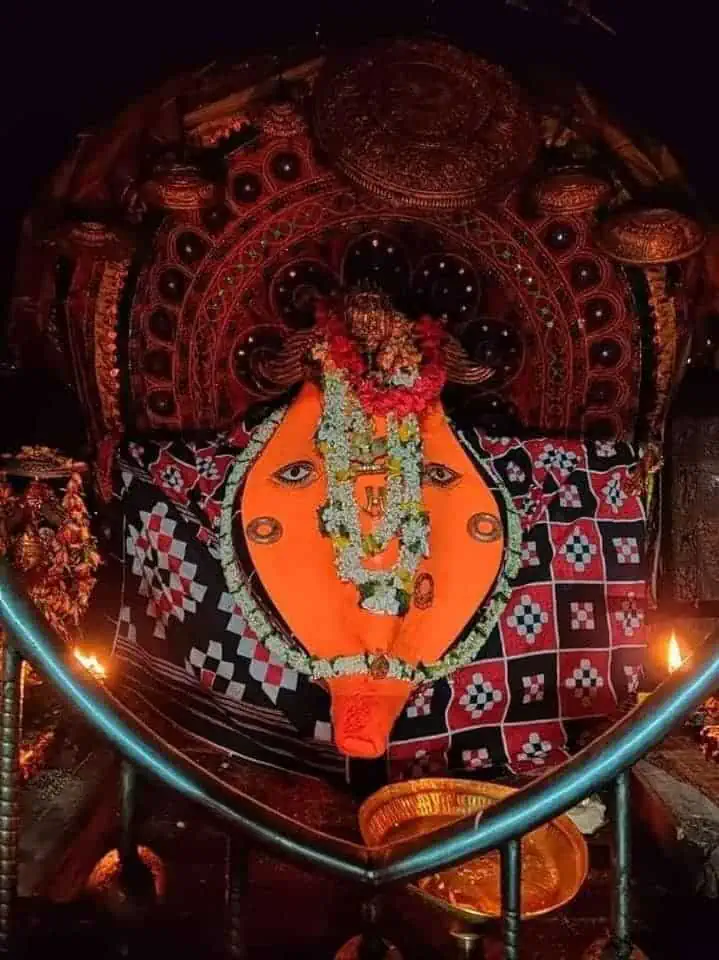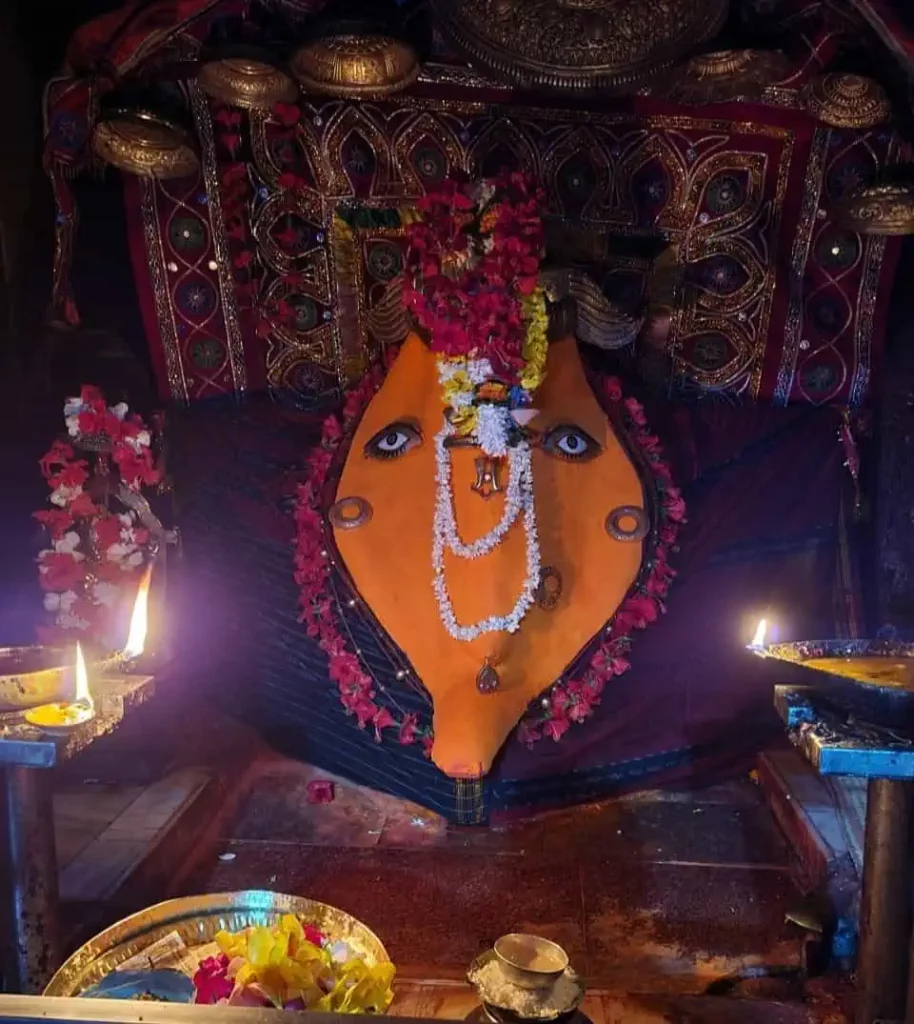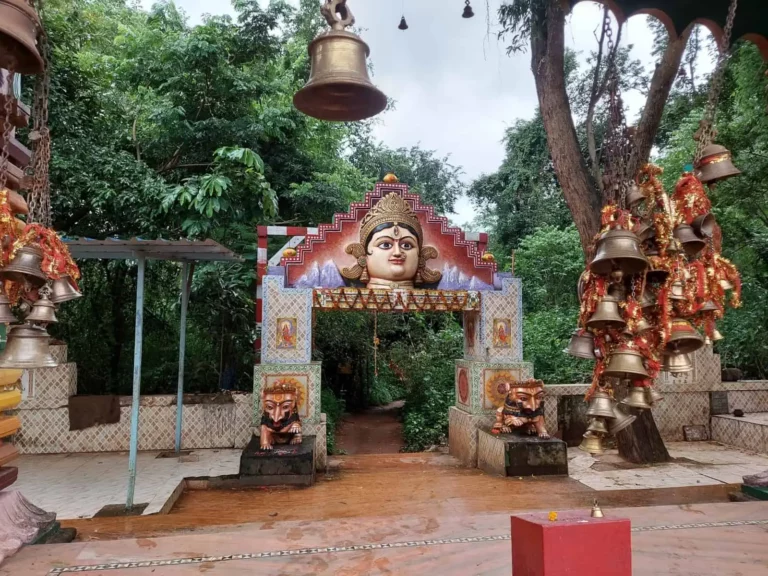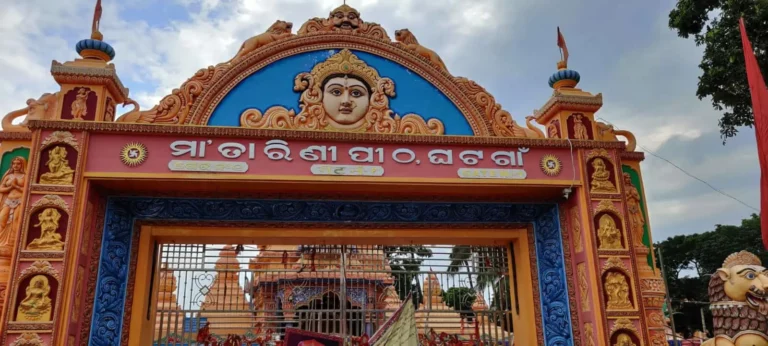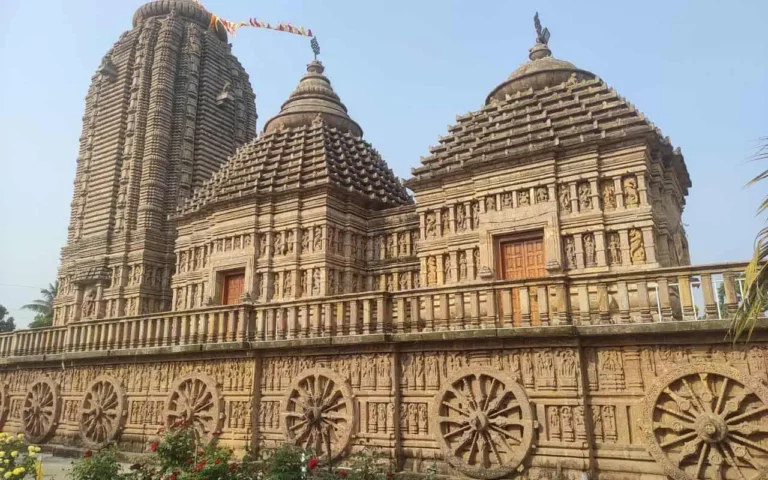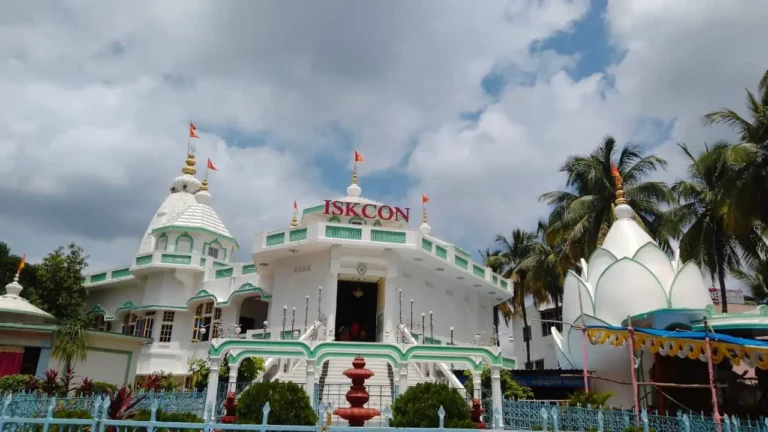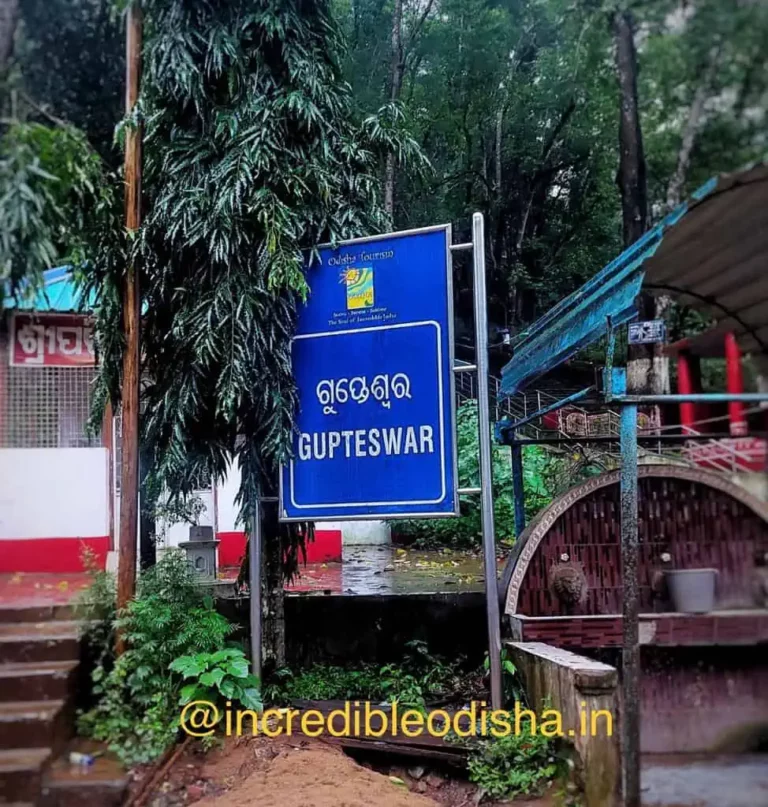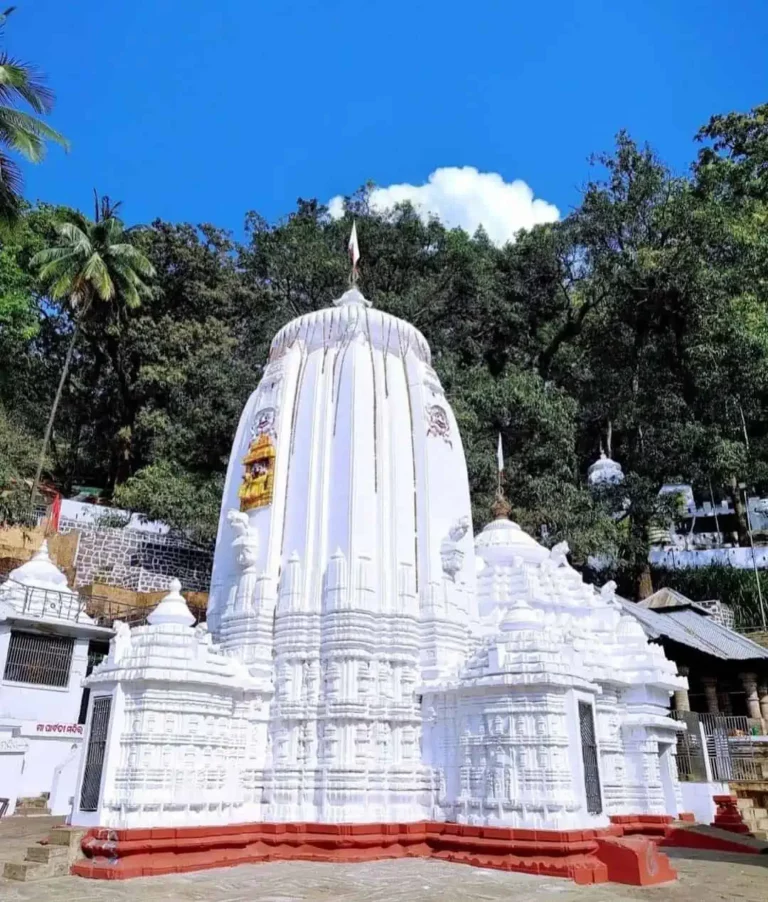Maa Samaleswari Temple – Samlei Mandir Sambalpur (History, Architecture, Timings and Photos)
Maa Samaleswari Temple also known as Samlei Mandir is a famous temple in Odisha. Situated at the heart of Sambalpur town the Maa Samaleswari Temple attracts lakhs of devotees throughout the year. Maa Samaleswari temple was built by King Balaram Dev of Chauhan in the 16th Century. Maa Samaleswari is the main deity worshipped in Sambalpur and is highly regarded in the western part of Odisha. She is an important symbol of Sambalpuri culture.
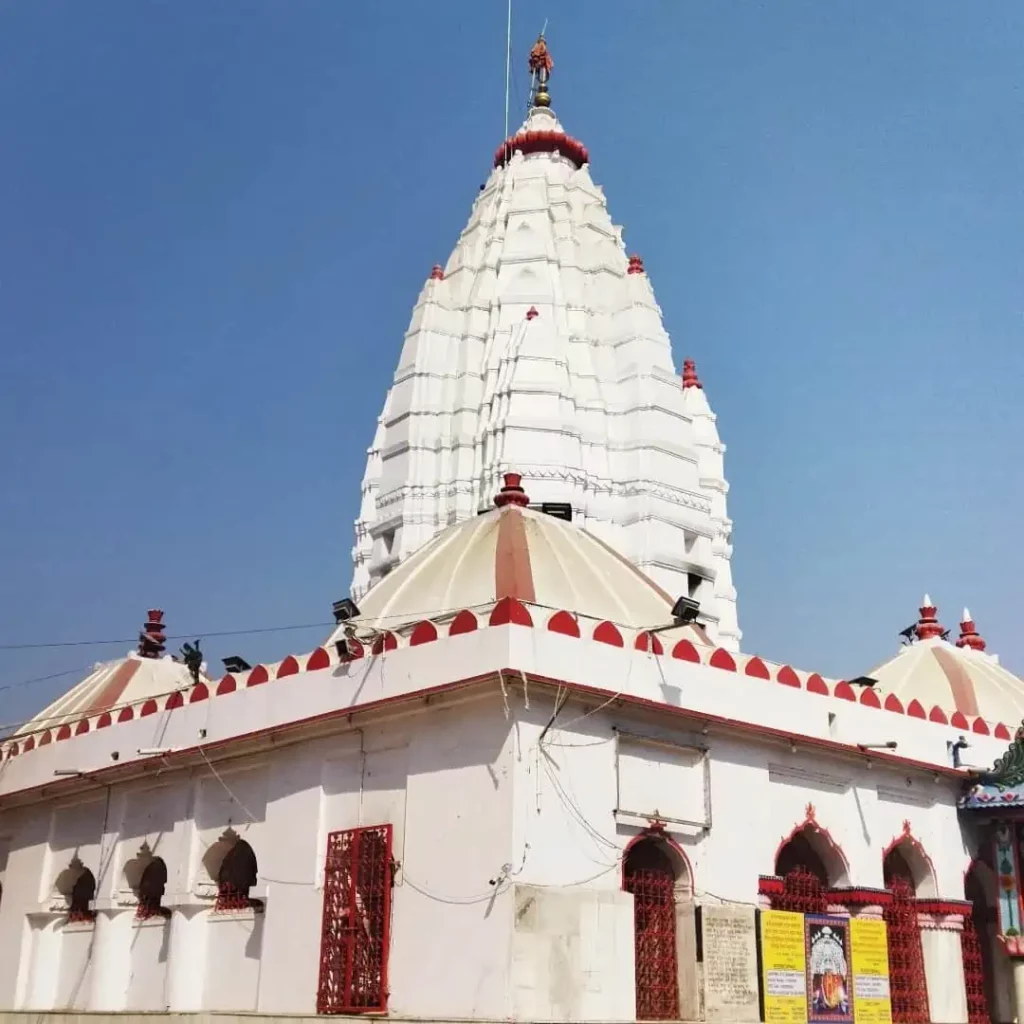
People have been worshipping the mother goddess Samaleswari on the banks of the Mahanadi river for a very long time.
She is known by many names such as Jagatjanani, Adishakti, Mahalaxmi, and Mahasaraswati. The region of Sambalpur has been called Hirakhanda for centuries.
The goddess was originally known as Somaleswari, meaning “one who bestows eternal bliss”. People also believe that she was worshipped under a Samel (cotton) tree, which is why she became known as Sameleswari, and eventually, Samaleswari.
Maa Samaleswari Temple Timings
| Day | Morning Timing | Evening Timing |
|---|---|---|
| Monday | 6 am–11:30 am | 3 pm–7:30 pm |
| Tuesday | 6 am–11:30 am | 3 pm–7:30 pm |
| Wednesday | 6 am–11:30 am | 3 pm–7:30 pm |
| Thursday | 6 am–11:30 am | 3 pm–7:30 pm |
| Friday | 6 am–11:30 am | 3 pm–7:30 pm |
| Saturday | 6 am–11:30 am | 3 pm–7:30 pm |
| Sunday | 6 am–11:30 am | 3 pm–7:30 pm |
Google Map location of Maa Samaleswari Temple: Click Here
Maa Samaleswari Temple Photos
History of Sambalpur
In the past, there was an independent kingdom called Patna, which is now Balangir District. This kingdom was ruled by Raja Narasingh Dev from 1540 A.D. to 1547 A.D. The capital of the kingdom was located near present-day Patnagarh town on the bank of the river Mayabati in Balangir District.
One night during the rainy season, the queen of King Narasingh Dev went into labour and experienced severe pain. Her life was at risk, and the only midwife who could help her was located in a village on the other side of the Mayabati river.
Unfortunately, the river was flooded with a swift current. Balaram Dev, who was present at the time, bravely swam across the river and carried the midwife on his shoulders to the queen. Thanks to the midwife’s care and treatment, the queen was able to safely deliver a son, who was named Hamir Dev.
King Narsingh Dev was very impressed by the bravery of his younger brother, Balaram Dev. As a reward for his courage, the king granted Balaram Dev a large tract of land. This land later became the kingdom of Huma Desh, which eventually became known as the independent kingdom of Sambalpur.
Balaram Dev ruled Sambalpur for a period between 1540 AD to 1557 AD. Later on, the Kings of Sambalpur expanded their territory to cover a vast area of Western Odisha and Chhattisgarh, which became known as Athara Garjat or 18 Garjat. This kingdom was eventually renamed Hirakhand.
History of Maa Samaleswari Temple
According to local stories, one day Balaram Dev went hunting on the right bank of the Mahanadi river with his hounds. While hunting, he noticed something strange happening. His hounds, instead of chasing a small rabbit, were being chased by the rabbit itself.
It seemed as though the hounds were terrified of the rabbit. The king was amazed and later saw that the rabbit returned to the foot of a huge cotton tree on the left bank of the Mahanadi and disappeared.
That night, Balaram Dev had a strange dream where Goddess Samaleswari appeared before him and said that she was residing in Gumadarha inside the river. She instructed him to establish her at the foot of the cotton tree and build a temple there. She then blessed the king and vanished.
The next morning, Balaram Dev considered the importance of the left bank of the Mahanadi river for both religious and administrative reasons and made up his mind to establish his fort there.
He installed the idol of Goddess Samaleswari under the cotton tree and built a temple in her honour. At that time, Sambalpur was just a small village. Some historians suggest that the idol of Goddess Samaleswari under the cotton tree was worshipped by tribals from the third century AD until the temple was built by Balaram Dev.
The Architecture of Maa Samaleswari Temple
The Maa Samaleswari Temple was constructed during the 16th century and later rebuilt by the seventh king of Sambalpur, Chhatra Sai Deo, who reigned from 1657 to 1665 AD. The temple is constructed from a type of stone that is as durable as granite and cemented with lime mortar.
The entire building is plastered. The main shrine of the temple is a square sanctum sanctorum, which is four steps below the 10-foot-wide (3.0 m) covered circumambulation. The circumambulation is supported by 12 stone pillars.
There are eleven Parswa devis, or side goddesses, embedded on the outer wall of the sanctum so that devotees can worship these deities during parikrama (circumambulation) through the vaulted circumambulation.
The arched roof begins at a height of 18 feet and tapers to a height of 35 feet. The king endowed vast landed property for the seva (service) and Puja (worship) of the deity to a group of Sevayats.
The idol of Shree Shree Samalai Devi is made of a large block of granite rock with an inverted, trunk-like projection at the bottom. A shallow cut on the idol’s face, resembling a “Baraha,” represents her mouth.
A traditional Sambalpuri nose ornament made of pure gold hangs down from her imaginary nose, and beaten gold leaves are fixed on two disproportionate golden-eye-like depressions on her face, serving as substitutes for her eyes.
The mass of self-shaped rock on which the mother deity’s idol is carved inspires sublime sentiments of awe, fear, reverence, devotion, love, and affection towards all-pervading motherhood.
Festivals Celebrated at Maa Samaleswari Temple
Maa Samaleswari Temple in Sambalpur is one of the most popular temples in Odisha, India. It is dedicated to Goddess Samaleswari, the presiding deity of Sambalpur. The temple is not only a religious site but also an important cultural landmark in the region.
One of the major attractions of the temple is the various festivals celebrated here throughout the year. Here is a guide to some of the most significant festivals celebrated at Maa Samaleswari Temple:
- Jyestha Purnima – On this day, Jalasayee of Bhairava Baba is celebrated with great enthusiasm.
- Sravana Purnima – The Srabanbhishek festival is celebrated on this day.
- Bhadraba Shukla Panchami – This day marks the celebration of Nuakhai, a popular harvest festival in Odisha.
- Bhadra Krushna Astami – Ambica Puja is celebrated on this day.
- Aswin Amabasya – Mahalaya, Dhabalmukhi or Ganga Darshan besha is celebrated on this day.
- Aswin Shukla Pratipada – Navaratri Pujarambaha is celebrated on this day.
- Aswin Purnima – Dhwajarohan and Raj-Rajeswari besha are the highlights of the celebrations on this day.
- Kartika Amabasya – Shyama Puja is celebrated on this day.
- Poush Purnima – Poushyabhishek festival is celebrated on this day.
- Magha Shukla Panchami – Maha Saraswati Puja is celebrated on this day.
- Magha Purnima – The Purnahuti of 24 Prahari Mahamantra Namyagna is the main attraction on this day.
- Makara Sankranti – Purnahuti of 3 days deepa mahayagna is celebrated on this day.
- Falguna Purnima – The Gundikhia and Dolapurnima festivals are celebrated on this day.
- Chaitra Shukla Pratipada – Basantika Navaratri Pujarambha is celebrated on this day.
- Bishuba Sankranti – Sitala Thakurani Puja is celebrated on this day.
- Akshaya Trutiya – Shree Shree Samaleswari bhajan Samaroha is the highlight of the celebrations on this day.
Visitors to the temple during these festivals can witness the vibrant culture of Odisha and experience the unique traditions and customs associated with each festival. The festivals of Maa Samaleswari Temple are a must-visit for anyone interested in exploring the rich cultural heritage of Odisha.
How to reach Maa Samaleswari temple
To reach Maa Samaleswari Temple, one can take any of the following modes of transportation:
- By Air: The nearest airport is the Veer Surendra Sai Airport, Jharsuguda which is located around 63 km away from Sambalpur. From there, one can hire a taxi or take a bus to reach the temple.
- By Train: Sambalpur railway station is well-connected with major cities in India, such as Delhi, Kolkata, Mumbai, Chennai, Hyderabad, and Bangalore. From the railway station, one can take a taxi, auto-rickshaw or bus to reach the temple.
- By Road: Sambalpur is well-connected by road with major cities in Odisha and neighbouring states. One can take a bus or hire a taxi to reach the temple.
Once you reach Sambalpur, the Maa Samaleswari Temple is located in the heart of the city and can be easily accessed by local transport. The temple is situated near Budharaja Hill and is easily identifiable due to its unique architecture and ancient history. Visitors can enjoy a peaceful and spiritual experience at the temple, which is considered one of the most significant shrines in Odisha.
Places to visit near Maa Samaleswari temple
There are several places to visit near Maa Samaleswari temple in Sambalpur. Here are a few options:
- Hirakud Dam: Located on the Mahanadi river, Hirakud Dam is one of the longest dams in the world. It offers a scenic view and is a popular spot for boating, picnicking, and photography.
- Sambalpur City: Sambalpur city is known for its rich cultural heritage and traditional handloom sarees. The city has several temples, museums, and parks that are worth visiting.
- Ushakothi Wildlife Sanctuary: Located about 45 km from Sambalpur, Ushakothi Wildlife Sanctuary is a popular destination for nature lovers and wildlife enthusiasts. The sanctuary is home to several species of animals, birds, and reptiles.
- Debrigarh Wildlife Sanctuary: Located about 90 km from Sambalpur, Debrigarh Wildlife Sanctuary is a popular destination for wildlife enthusiasts. The sanctuary is home to several species of animals, birds, and reptiles.
- Cattle Island: Located in the middle of the Hirakud reservoir, Cattle Island is a unique tourist attraction. Visitors can take a boat ride to the island and enjoy the scenic beauty.
- Samaleswari Temple Market: The market near Samaleswari Temple is a popular shopping destination. Visitors can buy traditional handloom sarees, handicrafts, and souvenirs from the market.
These are just a few of the many places to visit near Maa Samaleswari temple. Visitors can explore the region and discover more attractions.
FAQs on Maa Samaleswari temple
What is the significance of Maa Samaleswari temple?
Maa Samaleswari temple is one of the important Shakta shrines in Odisha and is believed to be one of the most powerful Shakti Peethas in India. It is believed that the goddess blesses her devotees with prosperity, happiness, and fulfilment of desires.
What is the best time to visit Maa Samaleswari temple?
The best time to visit Maa Samaleswari temple is during the festive season, which falls in the months of August-September and October-November. During this time, the temple is beautifully decorated and several cultural programs are organized.
Is there any entry fee to visit Maa Samaleswari temple?
No, there is no entry fee to visit Maa Samaleswari temple.
What is the dress code for visiting Maa Samaleswari temple?
Visitors are advised to dress modestly and cover their heads while visiting the temple. Shorts, sleeveless tops, and revealing clothing are not allowed inside the temple premises.
What are the timings of Maa Samaleswari temple?
The temple is open from 6:00 am to 11:30 am and from 3:00 pm to 7:30 pm, all days of the week.
Is photography allowed inside the temple premises?
No, photography is not allowed inside the temple premises.
Are there any accommodation facilities near Maa Samaleswari temple?
Yes, there are several budget and mid-range hotels available near Maa Samaleswari temple. Some popular options include Hotel Harjit Residency, Hotel Alok, and Hotel Sheela Towers.
